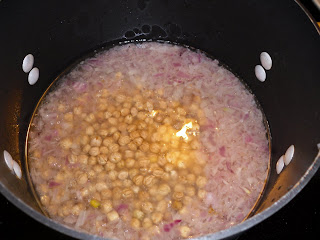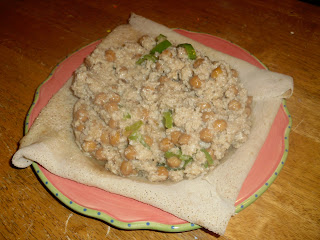I adore fitfit (stew mixed with injera); my most favorite Ethiopian dish is doro fitfit, the country's national dish (doro/chicken stew) mixed with injera. It's my "usual" when we go out for Ethiopian.
Last time I was on, I mentioned that we weren't too thrilled with the injera we had mail-ordered. The Ethiopians complained about a residue left on their fingers and tears started flowing when the injera, instead of being supple and elastic, more or less crumbled when they attempted to fold it around their food. So, despite having 20 pieces still left in the freezer, I decided to go back to getting injera fresh from our local restaurant (unless I make it myself), relegating the mail-ordered stuff to use in fitfit. How timely it was, then, that Random.org landed me right on a recipe for fitfit!
This is a very simple, very standard wet to make. There are no exotic ingredients to try to find and the preparation is straight-forward.
As with most wets (at least in this book), this one started off with a large quantity of red onion:
In Ethiopian cooking, you apparently never sauté the onions in oil or butter, though fat is used later on in the cooking process. Instead, you throw them into a dry pan and cook them that way, keeping a good eye on them and stirring them nearly constantly, as they are not supposed to change color (by that, they mean brown; they do become translucent as they are cooked).
After the onions, I added sunflower oil and water:
And dried chickpeas:
After letting it boil for 10 minutes, I was supposed to add some garlic and ginger and some more water, but I got a little ahead of myself and added the spices to the mixture before it boiled:
There's also some black pepper in there, as black pepper is mentioned in the ingredient list. It is never, however, mentioned in the recipe, so I just assumed it went in with the rest of the spices. And while only 1/4 teaspoon of garlic was called for, I used a teaspoon because I use these and one cube is roughly one teaspoon.
Then it was just a matter of cooking until the chickpeas became soft. No time was given, and I had purchased them in bulk from Whole Foods, so there were no cooking directions (I know they're on the bins, but I didn't pay attention to them), so a perusal of volume 3 of my Women's Day Encyclopedia of Cookery was called for.
This is my favorite cookbook set, from 1965. I sometimes just sit and leaf longingly through the pictures, feeling inexplicably nostalgic for the days of dinner parties, caftans, tureens and chafing dishes, Fiestaware, harvest gold, avocado green, and Americana decor, though I was born three years after these books were published!
According to the Encyclopedia, the chickpeas needed to cook for two hours. Unfortunately, it also said to soak them for an hour before cooking them for those two hours, but I didn't read that until the chickpeas had already been thrown into the pot. After all was said and done, however, they ended up simmering for about 3-1/2 hours because I had to run out to pick the Ethiopians up from daycare due to an emergency at my husband's work. As a disclaimer, I would like to add that we do eat a fair amount of beans, but I tend to use canned for convenience's sake, and haven't cooked from dried beans in ages; that's why I needed to look it up! You could also put the stew into a crockpot at this point until you're ready to have it.
After we got home, I added the finishing touches. First, some sliced Anaheim pepper:
Then the injera, which crumbled perfectly:
The finished piece:
I had to fold over the edges of the injera because it's too big for the plate!
Despite this not being a berbere dish, it was very good. Even though we don't like the mail-order injera as platter or utensil, it worked wonderfully in the fitfit and the end result is quite filling.










No comments:
Post a Comment